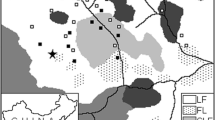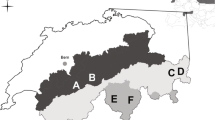Summary
Recent studies suggest that diet quality is responsible for differential survivorship of vole cohorts (Boonstra and Boag 1987) and spacing behavior of females (Ims 1987). These phenomena have been related either to a lack of or a deterioration in the quality of the preferred food. To test this hypothesis, we compared foods habits, food quality and health status of meadow voles (Microtus pennsylvanicus) from high and low population density phases. In this study, seven plant species represented the main food items used on a regular basis and biomass values of preferred species decreased with browsing pressure. In addition, food quality of the main dietary items changed between phases forcing females to adjust their feeding strategy accordingly. Health of voles changed also opening the way to speculations on competition for high quality food resources and survivorship.
Similar content being viewed by others
References
Batzli GO (1985) Nutrition. Pages 779–781. In: Tamarin RH (ed) Biology of New World Microtus, Special Publication No. 8, The American Society of Mammalogists, USA
Batzli GO, Pitelka FA (1970) Influence of meadow mouse populations on California grassland. Ecology 51:1027–1039
Batzli GO, Pitelka FA (1971) Condition and diet of cycling populations of the California vole, Microtus californicus. J Mammal 52:141–163
Beacham TD (1980) Survival of large and small adults in fluctuating populations of Microtus townsendii. J Mammal 61:551–555
Bélanger J, Bergeron JM (1987) Can alkaloids and tannins influence food choice of meadow voles (Microtus pennsylvanicus)? Can J Zool 65:375–378
Belovsky GE (1981a) Food plant selection by a generalist herbivore: the moose. Ecology 62:1020–1030
Belovsky GE (1981b) A possible population response of moose to sodium availablility. J Mammal 62:631–633
Benjamin MM, McKelvie DH (1978) Clinical biochemistry. In: Benirschke K, Garner FM, Jones TC (eds) Pathology and laborartory animals Vol. II. Springer, Berlin Heidelberg New York
Bergeron JM, Jodoin L (1984) Impact de 12 plantes communes de milieu ouvert sur les variations de poids corporel et de poids d'organes internes du campagnol des champs (Microtus pennsylvanicus). Can J Zool 62:50–57
Bergeron JM, Jodoin L (1987) Defining “high quality” food resources of herbivores: the case for meadow voles (Microtus pennsylvanicus). Oecologia 71:510–517
Bergeron JM, Juillet J (1979) L'alimentation estivale du campagnol des champs, Microtus pennsylvanicus, Ord. Can J Zool 57:2028–2032
Bergeron JM, Jodoin L, Drapeau G (1986) A comparison of blood plasma parameters in wild and laboratory meadow voles (Microtus pennsylvanicus). Lab Anim Sci 36:698–700
Bergeron JM, Jodoin L, Jean Y (1987) Pathology of voles (Microtus pennsylvanicus) fed with plant extracts. J Mammal 68:73–79
Boonstra R, Boag PT (1987) A test of the Chitty hypothesis: inheritance of life-history traits in meadow voles Microtus pennsylvanicus. Evolution 41:929–947
Boonstra R, Krebs CJ (1979) Viability of large- and small-sized adults in fluctuating vole populations. Ecology 60:567–573
Bryant JP, Chapin III FS, Klein DR (1983) Carbon/nutrient balance of boreal plants in relation to vertebrate herbivory. Oikos 40:357–368
Chitty D (1955) Adverse effects of population density upon the variability of later generations. In: Cragg JB, Pirie NW (eds) The numbers of man and animals. Edinburgh, pp 57–67
Chitty D, Chitty H (1962) Population trends among the voles at lake Vyrnwy, 1932–1960. In: Proceedings of the Symposium on Theriology, Brno, (1960), pp 67–76
Choo GM, Waterman PG, McKey DB, Gartlan JS (1981) A simple enzyme assay for dry matter digestibility and its value in studying food selection by generalist herbivores. Oecologia 49:170–178
Feeny P (1976) Plant apparency and chemical defense. Rec Adv Phytochem 10:1–40
Fox RL (1981) Defense and dynamics in plant-herbivores systems. Am Zool 21:853–864
Freeland WJ (1974) Vole cycles: another hypothesis. Am Nat 108:238–245
Golley FB (1960) Energy dynamics of a blood chain of an old-field community. Ecol Monogr 30:187–206
Hansson L (1988) Parent offspring correlations for growth and reproduction in the vole Clethrionomys glareolus in relation to the Chitty hypothesis. Z Säugetierkd 53:7–10
Haukioja E (1980) On the role of plant defenses in the fluctuation of herbivore populations. Oikos 35:202–213
Haukioja E, Hakala T (1975) Herbivore cycles and periodic outbreaks. Formulation of a general hypothesis. Report of the Kevo Subarctic Research Station 12:1–9
Hilborn R, Redfield JA, Krebs CJ (1976) On the reliability of enumeration for mark and recapture census of voles. Can J Zool 54:1019–1024
Ims RA (1987) Male spacing systems in microtine rodents. Am Nat 130:475–484
Jean Y, Bergeron JM (1986) Can voles (Microtus pennsylvanicus) be poisoned by secondary metabolites of commonly eaten foods. Can J Zool 64:158–162
Jung HJG, Batzli GO (1981) Nutritional ecology of microtine rodents: effects of plant extracts on the growth of arctic microtines. J Mammal 62:286–292
Kendall WA, Sherwood RT (1975) Palatability of leaves of tall fescue and reed canary grass and some of their alkaloids to meadow voles. Agron J 67:667–671
Krebs CJ (1964) The lemming cycle at Baker Lake, Northwest territories, during 1959–1962. Arctic Institute, North American Technical Paper No. 15, 104 pp
Krebs CJ (1978) A review of the Chitty hypothesis of population regulation. Can J Zool 56:2463–2480
Krebs CJ, Myers CJ (1974) Populations cycles in small mammals. Adv Ecol Res 8:267–399
Krebs CJ, Keller BL, Tamarin RH (1969) Microtus population biology: demographic changes in fluctuating populations of M. ochrogaster and M. pennsylvanicus in southern Indiana. Ecology 50:587–607
Lindroth RL, Batzli GO (1984) Plant phenolics as chemical defenses: effects of natural phenolics on survival and growth of prairie voles (Microtus ochrogaster). J Chem Ecol 10:229–244
Lindroth RL, Pajutee MS (1987) Chemical analysis of phenolic glucosides: art, fact, and artifacts. Oecologia 74:144–148
Lindroth RL, Batzli GO, Avildsen SI (1986) Lespedeza phenolics and Penstemon alkaloids: effects on digestion and growth of voles. J Chem Ecol 12:713–728
McKey DB, Gartlan JS, Waterman PG, Choo GM (1981) Food selection by black colobus monkeys (Colobus satanus) in relation to plant chemistry. Biol J Lin Soc 16:115–146
Milton K (1979) Factors influencing leaf choice by howler monkeys: a test of some hypotheses of food selection by generalist herbivores. Am Nat 114:362–378
Milton JS, Tsokos JO (1983) Statistical methods in the biological and health sciences. McGraw-Hill Book Company
Mitruka BM, Rawnsley HM (1977) Clinical biochemistry and haematological reference values in normal experimental animals. New York. Masson Publishing USA Inc.
Neal BR, Pulkinen DA, Owen DB (1973) A comparison of fecal and stomach contents analysis of the meadow voles (Microtus pennsylvanicus). Can J Zool 51:715–721
Noether GE (1971) Introduction to statistics. Houghton Mifflin Company, Boston, p 253
Owen DF, Wiegert RG (1976) Do consumers maximize plant fitness? Oikos 27:488–492
Renzulli CB, Flowers JF, Tamarin RH (1980) The effects of trapping design on demographic estimates in the meadow vole, Microtus pennsylvanicus. Am Nat 104:397–401
Rhoades DF (1979) Evolution of plant chemical defence against herbivores. In: Rosenthal GA, Janzen DH (eds) Herbivores: Their interaction with secondary plant metabolites. Academic Press, New York
Rhoades DF, Cates RG (1976) Toward a general theory of plant antiherbivore chemistry. Rec Adv Phytochem 10:168–213
Rosenzweig ML, Abramsky Z (1980) Microtine cycles: the role of habitat heterogeneity. Oikos 34:141–146
SAS Institute Inc. (1985) SAS user's guide: statistics 5th edition. Cary, North Carolina
Stenseth NC (1977) Evolutionary aspects of demographic cycles: the relevance of some models of cycles for microtine fluctuations. Oikos 29:525–538
Summerhayes VS (1941) The effects of vole (Microtus agrestis) on vegetation. J Ecol 29:525–538
Taitt MJ, Krebs CJ (1985) Population dynamics and cycles. In: Tamarin RH (ed) Biology of New World Microtus. Special Publication No. 8. The American Society of Mammalogists, pp 567–620
Tamarin RH, Reich LM, Moyer CA (1980) Meadow vole cycle within fences. Can J Zool 62:1796–1804
Thompson SW (1966) Selected histochemical and histopathological methods. Charles C. Thomas Publishers, Illinois
Voth EV, Black HC (1973) A histological technique for determining feeding habits of small herbivores. J Wildl Manage 37:223–231
Author information
Authors and Affiliations
Rights and permissions
About this article
Cite this article
Bergeron, JM., Joudoin, L. Patterns of resource use, food quality, and health status of voles (Microtus pennsylvanicus) trapped from fluctuating populations. Oecologia 79, 306–314 (1989). https://doi.org/10.1007/BF00384309
Received:
Published:
Issue Date:
DOI: https://doi.org/10.1007/BF00384309




